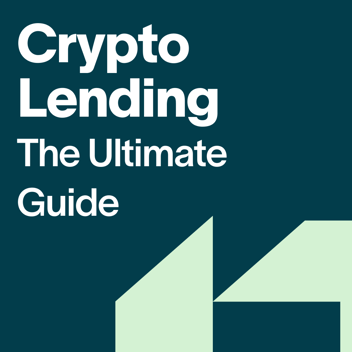Stablecoin Lending: The Ultimate Guide

Stablecoin lending is one of the most popular methods of earning interest in the crypto industry. With decent interest rates that are typically higher than interest rates on assets like BTC or ETH and reduced volatility, stablecoin lending seems like a very enticing idea to many people in this space. But how exactly does stablecoin lending work, and what should you know before you get started? Check out our ultimate guide to find this out, and more.
What is Stablecoin Lending?
Stablecoin lending is where users loan out their stablecoins (which are cryptocurrencies that are pegged to fiat or other assets such as gold) for a reward of some sort.
What are Stablecoin Loans?
A stablecoin loan is a crypto loan that involves stablecoins in some way. For instance, lending somebody a stablecoin, with the recipient being given a period of time to pay it back, or else they lose their collateral.
How Does Stablecoin Lending Work?
This process generally involves placing your stablecoins in a location that can be reached by a centralized third party or a decentralized network (such as a savings account, a growth account or liquidity pool). The stablecoins can then be accessed and used to provide loans to those who are interested. As a result, you will be given some ongoing financial reward, in the form of cryptocurrencies. These are usually in the same asset as the stablecoins you choose to lend out. You stop receiving rewards once you take your assets back and you decide to remove access to them.
-1.png?width=1800&height=1260&name=How%20to%20Earn%20Interest%20on%20Crypto%20(1)-1.png)
How to Lend Your Stablecoin
There are several methods of lending your stablecoins and earning interest on them. Let’s take a look at some of the most common options.
Crypto Savings Accounts
Opening a savings account is a major method of lending out your assets. This is where you place your stablecoins into a wallet or account which is managed by a third party, where they use your cryptocurrency to offer loans for others, and in return give you interest, typically entered into the account itself. These are usually operated by CeFi (centralized finance) services.
The best crypto savings accounts have strong reputations in the industry, are transparent and open with their user base, and have competitive rates. This is why Ledn is a top choice for many stablecoin users, as they are known to be reliable, with highly competitive interest rates, and they publish their monthly open-book reports and biannual proof-of-reserve data.
(DeFi) Decentralized Finance Protocols
There are many decentralized services which you can lend your stablecoins to. Some of these are explicitly lending protocols that aim to make the process of acquiring a loan more decentralized and distributed. However, many DeFi exchanges also offer the ability to lend to them. Usually, this occurs by sending your stablecoins to a liquidity pool, which is a smart contract-operated reserve that collects and manages assets from multiple participants.
In these liquidity pools, your stablecoins are pooled together with those from other users, creating a large reserve of funds. When someone wants to trade or borrow assets, they interact with this pool, ensuring there's always a supply of liquidity available. As a liquidity provider, you earn a portion of the trading fees or interest payments generated from these activities, proportional to your own contribution to the pool.
P2P Lending
While most lending in the crypto space happens either through a third party or a decentralized protocol, it is definitely possible to lend your assets directly to somebody. This would work by somebody borrowing your stablecoins, and you taking something as collateral in the process.
The agreement would be made between you and the other party. This could take the form of a traditional contract, a smart contract that has some features enabled that sends the collateral to you if the borrower doesn’t send a certain amount of the digital assets to a wallet within a timeframe, or it could be more informal than that with both of you verbally agreeing to follow each other’s rules.
Is Stablecoin Lending Safe?
Stablecoin lending is typically considered a safe practice, however, there are some aspects you should keep in mind before beginning.
All Lending Contains Some Risks
No matter what asset you are lending, there is some inherent level of risk involved. This is because you are entrusting another party with your funds. Some of the risk gets mitigated by setting high collateral for a loan, but this does not always completely eradicate it.
Stablecoins Can Crash
Stablecoins are known for keeping to one price that always tightly hovers around the rate of a fiat asset or precious metal. Generally, they are very good at this, and are often extremely close in their value. However, they sometimes have periods where they fall significantly below (or above) the target price. This is known as depegging, which was something that happened to USDC not too long ago. A reputable stablecoin that has a good reserve of assets backing it will likely fall back in line over a short period of time. Therefore, it is not usually a major issue.
That being said, it is also possible for a stablecoin to crash and lose all of its value. This happened with TerraUSD, which depegged so magnificently that it is unlikely to ever recover. The best way to avoid this from happening is to carefully research the stablecoin you decide to work with, and look hard to see what their risk management protocols are, and whether you trust them to be worthwhile.
CeFi Stablecoin Lending Services Can Face Bankruptcy
When you use a CeFi service, you are largely at the mercy of the company running it. If something occurs that leads to their collapse, then your stablecoins could be at risk, as the company may be in control of them. This is an issue some people faced with BlockFi, when they declared bankruptcy. To avoid such a fallout, make sure to only work with transparent CeFi companies that provide regular and accessible audits. Ledn’s new USD Stablecoin Growth Accounts are ring-fenced, meaning that you’re only exposed to the credit risk of the counterparties that generate your yield and not any platform bankruptcy risk.
DeFi Stablecoin Lending Protocols Can Get Hacked
DeFi lending has an additional layer of danger, where the network or the tools associated with it can get exploited. This could be due to a hack, or an elaborate phishing scam. It happens semi-regularly with DeFi services, and the issues it causes can range from having a liquidity pool drained (which contains user-funds), or even having assets stolen from wallets via malicious smart contracts. For prevention, you need to be extremely vigilant with what smart contracts you sign and which dApps you engage with, along with only using services that have their code consistently audited by trusted parties.
Stablecoin Lending Rates
When it comes to understanding interest rates associated with stablecoin lending (or any type of crypto lending), the rewards you get are tied directly to the risk involved. This means that higher interest rates usually indicate a higher level of risk. For stablecoin lending, this could manifest in worries about the reserves that the asset uses for its backing, regulatory concerns that could affect the whole sub-sector, or even fears that the asset it is pegged to might be volatile.
Interest rates are additionally affected by market demands. Stablecoin loans are favored by many people in this industry, and so for this reason, interest rates for lending are typically higher than they are for BTC or ETH. This is to match the desires of the market as a whole. Some other, smaller factors can affect rates, although these are the two main elements to be aware of.
Related Content: Best Stablecoin Interest Rates in 2024
Pros and Cons of Stablecoin Lending
Now that we have established some important points about stablecoin lending, let’s contextualize this discussion by looking at the pros and cons.
Pros of Stablecoin Lending
Earn While You Hold: Many stablecoin lending services (both CeFi and DeFi) give you the opportunity to earn additional funds while you hold your assets. This means you can increase your funds without the complexities or intensity of trading. It is a passive way of building wealth.
Less Volatility Than Standard Crypto Assets: Stablecoins are significantly less volatile than assets like BTC, ETH, or smaller altcoins. Rather, they are pegged to fiat, meaning they match their value. The current state of the market means that most stablecoins are pegged to the US dollar, for instance, $1 USD is equal to 1 USDC and 1 USDT.
Strong Interest Rates: You can find strong interest rates from stablecoin lending. For instance, with Ledn, you can earn up to 10.0% APY on your USDT and USDC via their Growth Accounts. This is a very decent return, which is typically higher than interest rates for non-pegged cryptocurrencies.
Cons of Stablecoin Lending
You Must Trust Another Party or Protocol: Lending your funds generally involves handing them over to a centralized third party, or a decentralized protocol. Both of these options require you to research the lending provider in question and trust that they will look after your stablecoins as best as possible.
Stablecoins Can Become Depegged: As mentioned earlier, stablecoins are not impervious to faltering. While they are known to be reliable and consistent, they can definitely depeg from their target currency and even crash. If this happens whilst you are lending them out, then you could face significant financial losses.
Regulatory Bodies Could Restrict Stablecoins: The cryptocurrency industry has not existed for very long, and many regulatory bodies are still discovering how to engage with them. It is entirely possible that some regulatory bodies could decide to restrict or impose negative rules on stablecoin companies in the future. This could cause problems for those who are currently lending them out, as actions like this could lead to the assets losing value.
What's The Best Option For Stablecoin Lending?
Given everything we’ve discussed, you may be left asking what the ideal stablecoin lending option is. The market is filled with a huge range of services, although if you are seeking an established provider that has a fantastic track record, then look no further than Ledn. This is a company that has a long legacy in the industry, acts with the utmost transparency by publishing its open-book reports and proof-of-reserve data, and has highly competitive interest rates for USDC and USDT. Ledn offers this service via its Growth Accounts– these are stablecoin savings accounts, where you input your funds and earn yield (or interest) for doing so. Ledn’s USD stablecoin Growth Accounts are fully collateralized with Bitcoin, making it one of the safest ways to earn yield. Be sure to check them out and see if they suit your needs.
Related Content: How does Ledn generate interest on its USD Stablecoin?
Conclusion
Hopefully, with this guide, you have enough information to begin your stablecoin lending journey. With Ledn, it is extremely easy to start earning a passive income on your USDT and USDC, with competitive rates, and under safe circumstances.
Sponsored by 21 Technologies Inc. and its affiliates (“Ledn”). All reviews and opinions expressed are based on my personal views.



